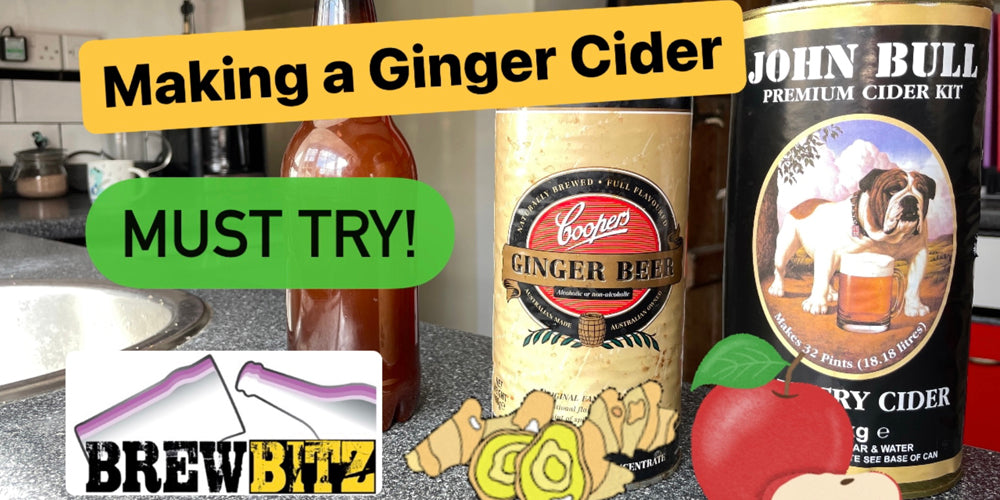- Cider Season -
The apples have started dropping indicating it's time to get picking the apples to make cider.
Everyone knows someone who lives nearby that has an apple tree brimming with apples left going to waste.
There are loads of apple trees growing wild where drivers have tossed out the core of an apple while driving.
There are apples EVERYWHERE!
But what if you cant get apples or don't have the means to extract the juice?
Did you know that the big cider makers juice all their apples now and then either reduce the water content so they have concentrated apple juice, or ferment it into cider then reduce the water content so the cider reaches 20% ABV then they add the water back later when they can or bottle it.
|
|
Cider Kits If you cant get your hands on enough apples, then you can make cider from our range of cider kits. Quick, cheap and easy to make, these kits make a really good cider that's better than you get in the shops.
Try using 2 cans of concentrate and no sugar to get a more intense apple flavour.
|
|
 |
John Bull Cider KitIf you like a good scrumpy, then this is the kit for you. Either just make 1 can (no sugar) to 20 pints or use 2 cans (no sugar) to 40 pints.
You can follow the instructions in the kit, but we think this gives a lot better flavour.
|
|
 |
Youngs Harvest Cider KitA new kit to the market, it creates a really crisp white cider. Use 2 cans and 1kg of sugar to remind you of the days of ciders like Diamond White.
But remember Diamond White was strong stuff!
|
|
 |
On The Rocks Cider KitsOn The Rocks have a range of cider kits all based on their cider kit, but with extra flavours so you can make apple cider, blueberry, peach and mango, raspberry and lime, raspberry blueberry and redcurrant and they even have a pear cider too
|
|
 |
Mangrove Jacks Cider KitThe Recipe No.1 Kit is a delicious rich smooth cider which comes with a sweetener sachet so if you like it dry, don't add the sweetener. If you like a sweet cider, then add all the sweetener, if you want it medium sweet, then add just half. It's up to you.
They also make fruity kits too, including a mixed berry, mulled apple cider and a citra hopped cider, so give them a go.
|
|
 |
Festival Oaked Apple Cider KitMy favourite cider kit, with lots of vanilla and woody flavours from the oak, lots of extra flavours from the apple chunks, rose hips, rowan berries and raisins which really ramp up the flavours and mouthfeel in this kit. This kit comes with 2 bags of brewing sugar to get the ABV up to 7.2%, but I prefer using just 1 bag to keep the ABV around 5.5%.
|
|
Making Cider From Juice It doesnt matter how you get your apple juice, whether you have picked, crushed and squeezed your apples or just bought some apple juice from the supermarket, the process is exactly the same.
Here are some basics that you will need when brewing your cider...
|
|
 |
PectolaseThis helps break down the cells of the apples and helps release more flavour and juice from the apples. If using pulped apples, sprinkle on your apples as you are crushing them. Mix it in and when you squeeze them, you'll get more juice.
|
 |
Cider YeastYes apples have lots of natural yeasts on them. Some will do a great job, others are lazy and will create weird flavours, so we recommend using campden tablets to subdue the natural yeasts, then use a cider yeast to get the fermentation going and make the best cider possible
|
|
 |
Campden TabletsThese do 2 things, they help stop the cider oxidising and helps keep a lush golden colour and it also helps to stop natural yeasts and bacteria from reproducing until your pitched yeast has taken the lead. The natural yeasts will start to reproduce after a few days and will do some interesting funky things in the background.
|
 |
SweetenerYeast eat all the sugar in apple juice, so your cider will be dry. If you like your cider sweeter, you'll need to add a sweetener. Adding more sugar is useless as the yeast will just eat it and make more alcohol. It will still be dry. If you like a sweet flat cider, you can use fermentation stopper to kill the yeast, then 48 hours later add sugar.
|
|
 |
Oak ChipsMy favourite ingredient to add to cider is oak chips. They add a delicious vanilla flavour and the cider really brings out the oak aromas. This takes a plain cider to another level. Toast your oak chips to get a roasty bonfire smokiness to the cider.
|
|
 |
Cider Making Starter PackageWe have a great little starter package which will help you make your first 10 litres of cider, with a fermenting bucket, syphon and bottles as well as the cider yeast, a thermometer and a hydrometer. You also get the nutrient, campden tablets and some cleaner and steriliser at a great price too.
£31.50
|
|
Ginger CiderLast week we told you of an experiment to make Ginger Cider, using a ginger beer kit and a cider kit. It's delicious!
If you want to make it you'll need a John Bull Cider Kit and a Mangrove Jacks Ginger Beer kit.
We are currently out of stock of the ginger, but they will be back in stock next week, or you can pre-order them now and we'll dispatch them as soon as they arrive here at Brewbitz.
|
|
This Months RecipeMunich Pilsner
We sell a lot of beer kits, but not many people know they can enhance a beer kit. In this recipe, we take a Tom Caxton Pilsner, a Muntons Munich Malt and swap the yeast out for a Mangrove Jacks Bohemian Lager yeast!
This takes a standard kit and turns it into something new.
|
|
|
Lets Get Brewing!
To make 23 litres you will need...
|
|
Ingredients
1 tin Tom Caxton Pilsner
1 tin Muntons Munich Malt Extract
1 sachet Mangrove Jacks M84 Bohemian Lager Yeast
2 litres boiling water
Cold tap water to top upto 23 litres |
|
Method:
1 - Pop the tins of malt into hot water to soften the LME
2 - Open and pour both tins into a 23 litre fermenter
3 - Use 2 litres of boiling water to rinse out the tins to get all the LME and pour this into the fermenter
4 - Top up the fermenter to 23 litres with cold tap water. I know the Pilsner instructions say less, but we are adding more Munich malt than is necessary
5 - Take a hydrometer reading and note this down for use later to calculate the ABV
6 - Check the temperature. It needs to between 10-15°C for this yeast
7 - Sprinkle on the yeast and I like to leave it 2 minutes, then stir it in
8 - Put the lid on and put somewhere cool between 10-15°C for 2 weeks
9 - Check with a hydrometer the fermentation is complete. The SG should be around 1.010-1.014. You can now use this with your initial reading to work out the ABV.
10 - Bottle with up to 3g of priming sugar for each 500ml bottle or 125g for the whole 23 litres.
11 - Cap the bottles and leave in the cool between 10-15°C for another 2 weeks to finish the secondary fermentation.
12 - If possible transfer to somewhere even cooler and leave to clear and the sediment to form a cement at the bottom of the bottle.
13 - Chill a bottle, open and pour into your glass in a slow continuous pour so you do not disturb the sediment. As soon as you notice sediment flowing to the neck stop pouring and you will have an amazing tasting Munich Pilsner.
If you can't get your temperatures this low, then use SafLager S-23 as this will happily ferment at warmer temperatures.
It's as simple as that. Cheers and Happy Brewing. |
|
|
That’s all from us for now.
We'll be bringing you some new recipes and videos for beer and wine in the near future, so keep your eyes peeled.
In the meantime, if you have any suggestions or questions about brewing, feel free to get in touch.
Until next time - Happy Brewing
Stay Safe.
Brew!
& Drink Responsibly.
Happy Brewing!
|
|
|
Brewbitz Homebrew Shop
01225 448080
Opening Hours
Mon - Fri 10:00 - 17:00
|
|
|
|

















